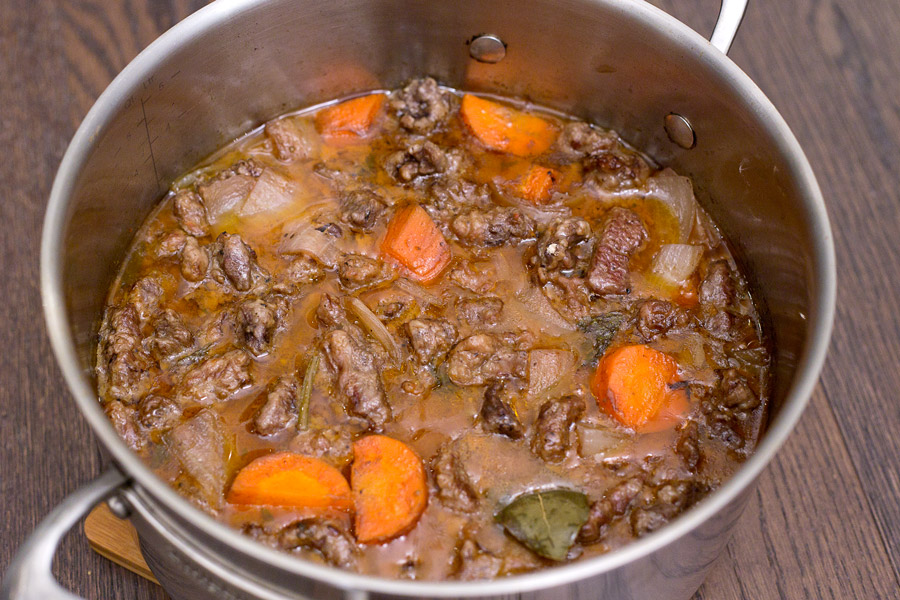
Recently, my boyfriend and I fell sick. More accurately, he fell sick and dragged me down with him (I may or may not have gone willingly). So as we sat sniffling, and weakly hacking up phlegm (TMI?), I couldn’t help but crave a large dose of hearty beef stew. It’s just one of those things that you want when it’s too cold to go outside, and you’ve realized that that the only thing starving when you’re ‘starving the cold’, is yourself.

I wanted a beef stew with a lot of carrot chunks, a hint of that onion sweetness and definitely more than a hint of red-wine. I won’t forget to mention the chunks of tender beef that have a nice seared crust on the outside but melt in your mouth once you get past all that goodness. I wanted beef stew that was so flavourful that it tasted like it was bathed in butter, but in reality there is no butter used at all.
Beef stew does require a little bit of preparation to make (unless it’s from a tin can), such as chopping the carrots, celery and onion before hand, but these steps are very easy. It is important that you use the right type of stew meat that will compliment that lengthy simmering time. I know buying a huge chunk of meat can be a little intimidating, but trust me, if you purchase any ‘Boneless Blade Roast’, your hearty beef stew will turn out just fine.
The following Beef Stew recipe is roughly adapted from the two cookbooks ‘Easy Recipes’ from Christine’s Recipes and ‘The New Best Recipe’ from America’s Test Kitchen. There is a slight variation of ingredients and cooking method to both recipes, and I mismatched parts of them along with my own knowledge.

Finally, I suggest you check out the notes section at the bottom, I will list some helpful hints and explanations there.
Hearty Beef Stew Recipe
YIELD: 6 portions
TOTAL TIME: 2 hrs 10 mins (30 mins. active prep time + 1 hr 40 mins inactive cook time)
CREDITS: Adapted from ‘Easy Recipes’ by Christine’s Recipes and ‘The New Best Recipe’ by America’s Test Kitchen
INGREDIENTS
- 2 lb (910g) Boneless Blade Roast
- 1 large onion (chopped coarsely)
- 1 large carrot (cut into slices roughly 2 cm thick )
- 1 celery stalk (cut into slices roughly 1.5 cm thick)
- 4 cloves garlic
- 200 ml red wine (look for ‘dry and full bodied’ i.e. Merlot, Shiraz, Cabernet Sauvignon)
- 600 ml chicken broth
- 2.5 tbsp. tomato paste
- 2 bay leaves
- pepper
- salt
- plain flour
- cooking oil
INSTRUCTIONS
- Prepare the blade roast by trimming and discarding the excess fat. Cut the rest of the meat into 1 inch cubes and pat dry with paper towel. Generously season with salt and pepper, followed by tossing in flour until each piece is evenly coated.
- In a big pot or dutch oven, heat a small amount of cooking oil over medium high heat and sear the outside of the meat until it turns golden and/or a crust forms (this action is called browning). Brown the meat in several batches, leaving 1 – 2 cm space between each piece to avoid overcrowding the pot. Overcrowding will cause steaming action instead of browning and will result in soggy meat rather than developing a delicious crust.
- After browning, set the meat aside and add some more cooking oil in the same pot. Sauté the garlic, carrots, onion and celery until fragrant, roughly 4 – 6 minutes.
- Pour in the red wine and chicken broth and bring to a boil. Mix in the tomato paste, browned meat and bay leaves. Cover the pot and turn the heat down to maintain a gentle simmer for 1 hour and 40 minutes. A gentle simmer means you can expect to see a small air bubble break the surface every few seconds.
- After simmering, taste and season the beef stew and when satisfied, ladle to a serving dish and enjoy!
NOTES
- Make sure the meat is dry before seasoning and flouring and this will help the flour adhere evenly to the meat.
- The red wine, tomato paste and lengthy simmering time serve to add flavor and break down the connective tissues in the meat, making it more tender.
- Overcrowding the pot/pan is one of the most common mistakes made in the home kitchen. Overcrowding prevents moisture from the meat from escaping which results in steaming rather than searing. If your desire is to form a crust on the meat, make sure to avoid overcrowding.












